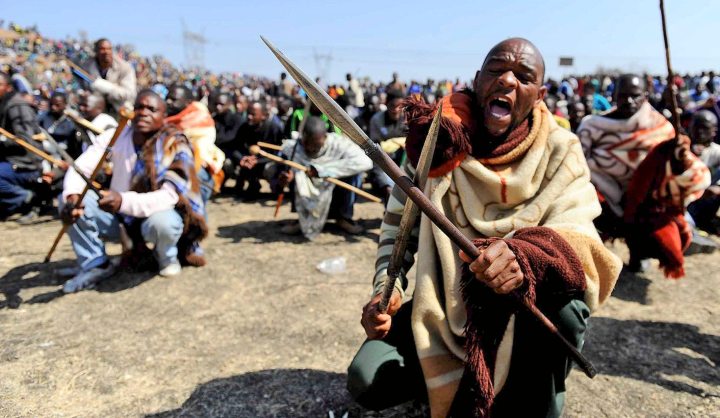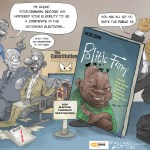South Africa
Op-Ed: Piketty misses the mark on Marikana

In an excerpt from a plenary lecture he presented to the International Sociological Association World Congress in July 2014, PETER ALEXANDER argues that while Thomas Piketty has produced a seminal tome that greatly enhances our understanding of a critical problem facing humanity, his treatment of Marikana reveals significant limitations.
On August 16 2012, the South African police intervened in a labor conflict between workers at the Marikana platinum mine near Johannesburg and the mine’s owners: the stockholders of Lonmin, based in London. Police fired on the strikers with live ammunition. Thirty-four miners were killed.
These lines may be familiar. They are the first ones in the first chapter of Thomas Piketty’s bestselling book Capital in the Twenty-first Century.
Piketty refers to what happened at Marikana as a “tragedy”. It was the outcome of – I will quote him – “distributional conflict” between, on the one hand, workers living in “wretched conditions” and, on the other, “Lonmin’s excessive profits” and “the apparently fabulous salary awarded to the mine’s manager”. It symbolised the inequalities that lie at the heart of his concerns, and it provided a glimpse of a ‘spectre’ (not his word), that of a threat to “democratic societies” and “values of social justice” posed by “a market economy … left to itself” (those are his words).
He observes Marikana from afar, picking it out with the telescope of historically grounded economics. What can be added if we see it close up, with the microscope of forensic sociology?
One could point to accidents of history in an account of Marikana – the significance of a single National Union of Mineworkers (NUM) member releasing a bullet, for instance – or one could treat it as a peculiarly South African event, which in many respects it was. But Piketty pushes us in the other direction, towards the bigger picture, and this is part of his strength. Certainly Lonmin is a sizeable corporation (a constituent of the FTSE-250 index) and South Africa is a Group of 20 country with a democratic and pro-capitalist government, so the massacre cannot be written off as an aberration. For Piketty, Marikana is symptomatic of a global malaise; part of the sickness of capital in the 21st century. But has he correctly diagnosed what’s wrong? What happens if we factor in our microscope findings?
First, we must challenge Piketty’s view of Marikana as a “distributional conflict”. Of course, a fight over wages is necessarily a fight over distribution of the value added to a product in the course of its production – that is, how much goes to the workers and how much to the owners and their representatives. But in the Marikana case workers demanded just rewards for (1) the quantity and quality of work performed and (2) the rotten conditions under which they laboured. These issues were, in essence, about production. I am not arguing that the struggle should be characterised as being about “production” rather than “distribution” – after all, success was measured in monetary terms.
Emphasis on the production aspect is important though, and for two immediate reasons. First, when workers protested, they did so by striking – that is, by halting production – and it was this that eventually brought success. Secondly, to appreciate why workers regarded the outcome of their 2014 strike as a victory, it is necessary to look beyond wages. Economists do not understand this because they only deal with numbers; sociologists have the ability to consider imponderables as well. In this case, the workers returned to their jobs far more united than before the action began. They had learned the benefit of solidarity, found new leaders and built new organisations (most importantly, at the point of production). In addition, they narrowed pay differentials, and gained some revenge for the massacre. After the strike, workers were more likely to be treated with dignity by their bosses, and they gained confidence to confront unsafe and unpleasant working conditions and to resist retrenchments. The strike improved wages, but it also shifted the balance of power over production in the workers’ favour. Refocusing attention on production signals the importance of workers in effective struggles against inequality.
This first concern relates to a second, more theoretical, problem. Marxist writers have criticised Piketty for conflating capital and wealth. Not all wealth is capital, it may just be a worker’s house for instance. A benefit of Marx’s approach is that it treats capital as a set of social relationships; not just a thing with a price. Private ownership is a critical relationship, one that gives shareholders control over production, allowing them to compel workers to create surplus value. This provides an important clue to understanding Marikana. Remember, Lonmin executive Bernard Mokoena wanted the South African Police Service to break the 2012 strike because a workers’ victory would encourage support for nationalisation, and thus a loss of ownership. In reality, capitalists never have unbridled control. They operate within structures of laws, agreements and customs that reflect their common interests and assist them in managing workers’ grievances. Mokoena is important here too. His support for potentially fatal repression was also conditioned by the desire to protect existing labour practices, including cosy relationships with the NUM. Marikana was not just a battle between rich and poor over the distribution of income, it was also a conflict over the right to determine the level and form of exploitation. That is, it threatened capital as a relationship.
This takes me to a third concern. The timing of the Lonmin conflict is significant. It did not occur when surplus extraction was at its height, but later. During the boom years from 2000 to 2008, Lonmin achieved a profit-to-labour ratio that averaged 62:38 (that is, after costs, 62% of income went to capital and only 38% went to labour, mainly through wages). In 2009, with the delayed impact of the crash at its worst, the company recorded a loss. In 2010-2011, it recovered, but the ratio was only 42:58, much less than in earlier years. Lonmin was still making a profit, but not enough to satisfy shareholders, and by 2012 its space to make significant concessions to workers was much reduced. While Marikana did, as Piketty argues, reflect problems with the “market economy”, it was linked specifically to the 2007/8 crash, that is, a specific economic crisis. For Marxists, a crash was predictable, and explicable as part of the dynamics of capitalism (that is, capital as a set of relationships). The Marikana uprising should be seen – along with the global wave of massive popular protests that have occurred over the past five years – as a symptom of capitalism in crisis, rather than simply a response to inequality.
The fourth concern takes a different tack. Piketty does not refer to Marikana as a massacre; it was just a “tragedy”. The same terminology was adopted by the South African government, which did so in a co-ordinated fashion. While ‘tragedy’ connotes things like accident, calamity, misfortune, affliction, and so forth; ‘massacre’ implies the killing of many people (or animals) at one time, in circumstances where there is an imbalance of forces. Marikana was indubitably a massacre (even if ‘tragedy’ might be used as a synonym). It is unlikely that Piketty’s selection of words was politically motivated, but nor, I think, was it accidental. For him, conflict over inequality is inevitable. The detail of who did what to whom and with what intentions and effects is not interesting. Defining Marikana as a ‘massacre’ recognises that victims were killed by the police and poses questions about the culpability of Lonmin, the government, the NUM and, specifically, Deputy President Cyril Ramaphosa. There was nothing inevitable about the massacre, it was the product of human volition.
This moves me on to a fifth matter. In some respects, the post-apartheid state has been quite progressive, and this is partly why the massacre was so shocking. The African National Congress has sought to build a new black bourgeoisie while sustaining a pact with trade unions; and, although this has provided a base for social reforms, it also produced a tightly knit grouping with common interest in repressing the Lonmin strikers. I emphasise this point because, whereas, for Piketty, the inequality upturn was a product of a 1980s “conservative revolution” led by Margaret Thatcher, neo-liberal policies were being implemented earlier – in the case of Britain, under a Labour government that had a social contract with union leaders (there were no massacres, but powerful sections of the working class were decisively weakened, partly through police action). Social democracy was implicated in both neo-liberalism and the massacre.
And, thus, to my sixth and final concern. What are the practical consequences of all this? At the end of his penultimate chapter, Piketty returns to Marikana to argue that “for collective action, what would matter most would be the publication of detailed accounts of private corporations”, adding: ‘the published accounts of Lonmin Inc do not tell us precisely how much the wealth produced by the mine is divided between profits and wages”. Actually, accounts detailing this division were available at the time of the five-month strike, and their impact was marginal at most. From what I saw, things like injustice, duty, self-sacrifice, honest leadership, endurance, bravery and solidarity were rather more important. Piketty’s failure to grasp this detail is part of a larger problem.
His “major conclusion” is that “the history of the distribution of wealth has always been deeply political”, but his own proposals, for democratic control of capital and a new global tax regime, seem puny when set against the magnitude of the problem he describes. The last decline in global inequality, in the first half of the 20th century, was, he argues – and I would agree – a consequence of two world wars, the Russian Revolution, the 1930s slump, etc. The conservative revolution at the end of the century rested on the collapse of the Soviet Union, the defeat of major workers’ movements and the imposition of structural adjustment all over the world. Rather than following his theory of big conflicts and massive processes marking shifts in the world history of inequality, he ends with a whimper of Fabian-style intellectual persuasion.
Piketty has produced a seminal tome that greatly enhances our understanding of a critical problem facing humanity, and he has encouraged valuable debate. However, his treatment of Marikana reveals significant limitations. His telescope picks out killings on the horizon, and he misses vast plains of complexity and contradiction that lie between there and the mountain of inequality data on which he stands. This middle ground is filled with a series of relationships: production/distribution, ownership/wealth, crisis/resistance, structural change/human agency, capitalism/reformism, and outcomes/programmes. A great strength of the work by the authors of Capital (in the 19th century), Karl Marx and Friedrich Engels, is that, in contrast to Piketty, they explored this middle ground. They did so by drawing on a more varied and richer body of scholarship than that accessed by Piketty, but, also, through lifelong participation in struggles to change the world.
Practical engagement is generally frowned upon in the academy. In my view this is a mistake. It provides knowledge that is otherwise hidden, releasing ideas that pierce accepted wisdom. Piketty made good use of Marikana to exemplify the horrors of capitalism, but the massacre epitomised much more, including collusion between corporate capital and a democratic state. Most importantly, Marikana showed that: having been floored by vicious repression, ordinary working people were able to find the resources to continue their struggle, and, eventually to win. It is battles like this that signal the basis for blocking the advancing juggernaut of inequality and injustice. DM
Photo: Striking South African mineworkers armed with homemade spears and pangas chant slogans at the Wonderkop informal settlement near Marikana platinum mine, Rustenburg, South Africa, on the day pf the massacre, 16 August 2012. EPA/STR
















 Become an Insider
Become an Insider